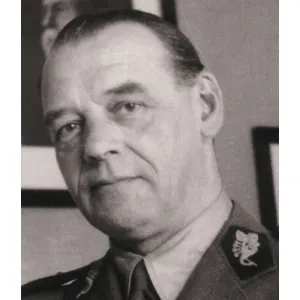Viest, Rudolf
Viest, Rudolf (24 September 1890, Revúca, today's Slovakia – 1945?, Flossenbürg concentration camp?, Germany) — Slovak military leader, member of the Czechoslovak government in exile, the commander of the resistance’s 1st Czechoslovak army during the Slovak National Uprising (Slovenské národné povstanie) and the only Slovak general during the interwar period in the first Czechoslovak Republic (Československá republika, ČSR).
Viest lived in the town Revúca until the death of his father, Gustáv, in 1905. After that, his family moved to Budapest. After graduating from higher industrial school, he stayed in Budapest till October 1911, when he was called up as a volunteer for one-year military service, which he served with the 7th Infantry Regiment in Graz. On 1 August 1914, after the announcement of general mobilization, he joined the 5th Infantry Regiment and went to the front as a platoon commander. As a soldier of the Austro-Hungarian army, he was captured near Kraków on 24 November 1914. In August 1915, he enlisted in the Serbian army. After that, he fought in the 1st Serbian Volunteer Regiment at Dobrudja, was wounded in battle but later returned to the front as second lieutenant as part of the Serbian troops.
In February 1917, he requested an assignment to Belgorod in Russia to help form the Czechoslovak Legions, the volunteer armed forces primarily made up of Czechs and Slovaks fighting alongside the Entente powers. From June 1917, he remained in Russia, serving as a second lieutenant and organizing the recruitment of volunteers. In 1919 he was appointed commander of the Czechoslovak camp for Slovaks in Irkutsk. In 1920, via Japan, Canada, and the USA, he returned to Czechoslovak Republic as a regimental commander with the rank of major.
On 1 January 1921, he joined the Czechoslovak army. After graduating from the Military Academy in Prague (Vysoká škola válečná) as an officer of the General Staff, he held the post of deputy military attaché in Budapest from 1922 to 1923. During the following years, he served in many positions such as chief of staff, regimental commander and commander of the entire Corps. He was the only Slovak in the Czechoslovak army (1918 – 1939) who held the rank of general. In 1933 he was appointed brigadier general and, in 1938, division general.
He did not accept the establishment of the pro-Nazi Slovak Republic (Slovenská republika) and, together with other cultural and military leaders, signed a declaration protesting against the declaration of the Slovak state. After the formation of the Slovak Army, he became General Inspector of the Slovak Army. As a member of the Slovak-Hungarian delimitation commission in August 1939, he did not return from the negotiations in Budapest but went to Yugoslavia, and then in mid-September 1939 on to France, where he became a member of the Czechoslovak National Committee in Paris (Československý národný výbor v Paríži). From January to June 1940, till the fall of France, he commanded the 1st Czechoslovak Division in France.
After the defeat of France, on 25 June 1940, he boarded a ship that sailed from Séte and arrived in Liverpool via Gibraltar on 7 July 1940. After an agreement with the British government of 22 July 1940, the Czechoslovak government-in-exile was established in London, headed by President Edvard Beneš. In government, Viest was State Secretary from 23 July 1940. From 1941-1944 he worked in the highest Czechoslovak exile bodies: from 8 May 1942, he was Deputy Minister of National Defence. On 28 March 1942, in Slovakia, he was deprived of Slovak citizenship in absentia and sentenced to death by hanging.
From 22 August 1944, he was a member of the delegation of the Czechoslovak government-in-exile at the negotiations in Moscow. There he received news of the outbreak of the Slovak National Uprising and at the suggestion of the Minister of National Defence of 6 September 1944, President Beneš appointed him commander of the 1st Czechoslovak Army on 19 September 1944, which he took command over on 7 October 1944. On 13 October 1944, he was co-opted as a member of the Slovak National Council (Slovenská národná rada).
From the beginning of the final German offensive, he commanded the retreat of the insurgent army. Under his command, the headquarters moved from the town Banská Bystrica to the village Donovaly. On 28 October 1944, in the early morning hours, Generals Rudolf Viest and Ján Golian, and other officers moved from Donovaly and headed east, towards the area of the mountains Poľana. During the first few days, the march did not encounter German troops but instead had to overcome immense hardships caused by unfavourable weather conditions. On 31 October 1944, a shootout with German troops took place. Rudolf Viest was exhausted from the huge physical effort and his illness, thrombosis of the lower limbs, worsened. On 2 November 1944, Generals Viest and Golian together with a group of soldiers reached the village Pohronský Bukovec, where they found a hiding place. In this village, the generals were captured the next day. After interrogation, they were escorted to Banská Bystrica and later to Bratislava. From there, they were transported to Vienna on 10 November 1944 and on the same day to Berlin. From there they were probably taken to the Flossenburg concentration camp and murdered there.
Army General (in memoriam) Rudolf Viest was awarded many Czechoslovak, Slovak, and foreign military decorations during his life and after his death. These include the Czechoslovak War Cross 1914–1918 (Československý vojnový kríž 1914–1918), the Ordre national de la Légion d'honneur (National Order of the Legion of Honour), the Czechoslovak War Cross 1939 (Československý vojnový kríž 1939) and many others.
